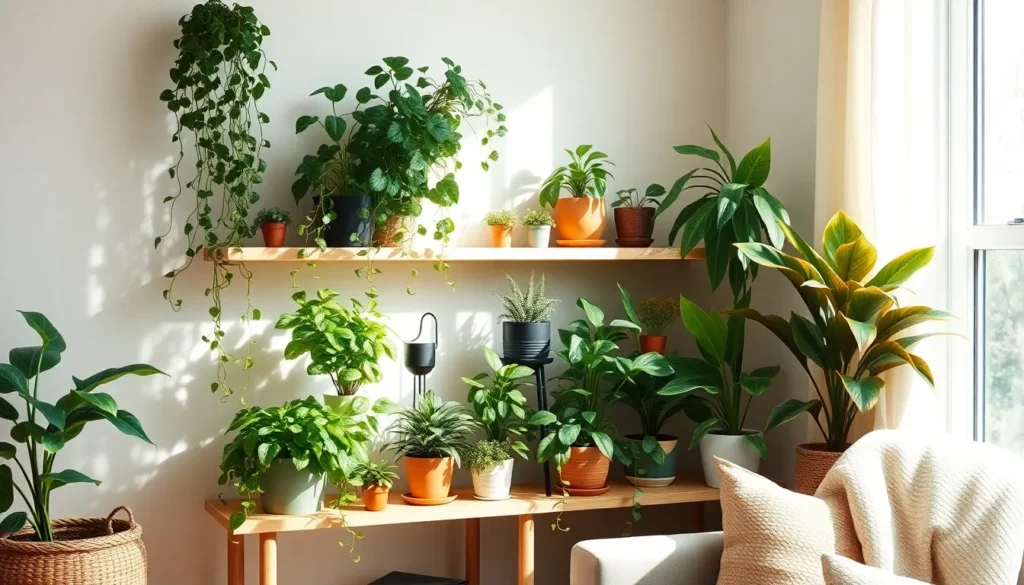Transform Your Unused Corners into Thriving Plant Sanctuaries
We’ve all got those awkward corner spaces that seem impossible to decorate effectively. But what if we told you these forgotten areas could become the perfect showcase for your growing plant collection? Corner shelves for plants aren’t just space-savers – they’re game-changers that’ll revolutionize how you display your green friends.
These vertical answers maximize every inch of your home while creating stunning botanical displays that’ll make your guests green with envy. Whether you’re dealing with a tiny apartment or a sprawling house corner plant shelves help you think beyond traditional floor space.
From sleek modern designs to rustic wooden tiers we’ll explore the best corner shelving options that’ll turn your plants into living art pieces. Ready to discover how these clever storage answers can transform your space into an indoor jungle paradise?
Choose the Right Corner Shelf Material for Your Plants
Material selection plays a crucial role in creating the perfect corner plant display that balances functionality with aesthetic appeal. We’ll explore three primary materials that offer distinct advantages for your corner shelving needs.
Wood Corner Shelves for Natural Appeal
Wood corner shelves create an organic foundation that complements plant life beautifully. We recommend cedar, teak, or bamboo for their natural moisture resistance and durability in humid plant environments. These materials develop a gorgeous patina over time that enhances their rustic charm.
Popular wood options include reclaimed barn wood for farmhouse styles, walnut for mid-century modern looks, and pine for budget-conscious buyers seeking natural appeal. We’ve found that wood shelves work exceptionally well with trailing plants like pothos and philodendrons.
Maintenance requires occasional oiling to preserve the wood’s integrity and prevent water damage from plant watering. Prices typically range from $30 to $150 depending on wood type and craftsmanship quality.
Metal Corner Shelves for Modern Durability
Metal corner shelves deliver unmatched strength and contemporary styling for your plant corner arrangements. We prefer powder-coated steel and wrought iron for their rust resistance and ability to support heavy ceramic planters without sagging.
Black metal frames create striking contrasts with green foliage, while copper and brass finishes add warmth to modern plant displays. These materials handle moisture exceptionally well and require minimal maintenance beyond occasional dusting.
Weight capacity becomes a important advantage with metal shelving, supporting multiple large plants like fiddle leaf figs and monstera deliciosas. Costs range from $25 to $200 for quality metal corner plant shelves.
Plastic Corner Shelves for Budget-Friendly Options
Plastic corner shelves offer affordability and versatility for beginning plant enthusiasts and renters. We recommend high-density polyethylene (HDPE) and polypropylene materials for their UV resistance and lightweight portability.
These shelves excel in humid environments like bathrooms and kitchens where wood might warp and metal could rust. Color options include white, black, and earth tones that blend seamlessly with various decor styles.
Assembly typically requires no tools, making them perfect for temporary plant arrangements or frequent room reorganization. Budget-friendly pricing starts at $15 and rarely exceeds $60 for multi-tier corner plant stands.
Consider Weight Capacity and Plant Size Requirements
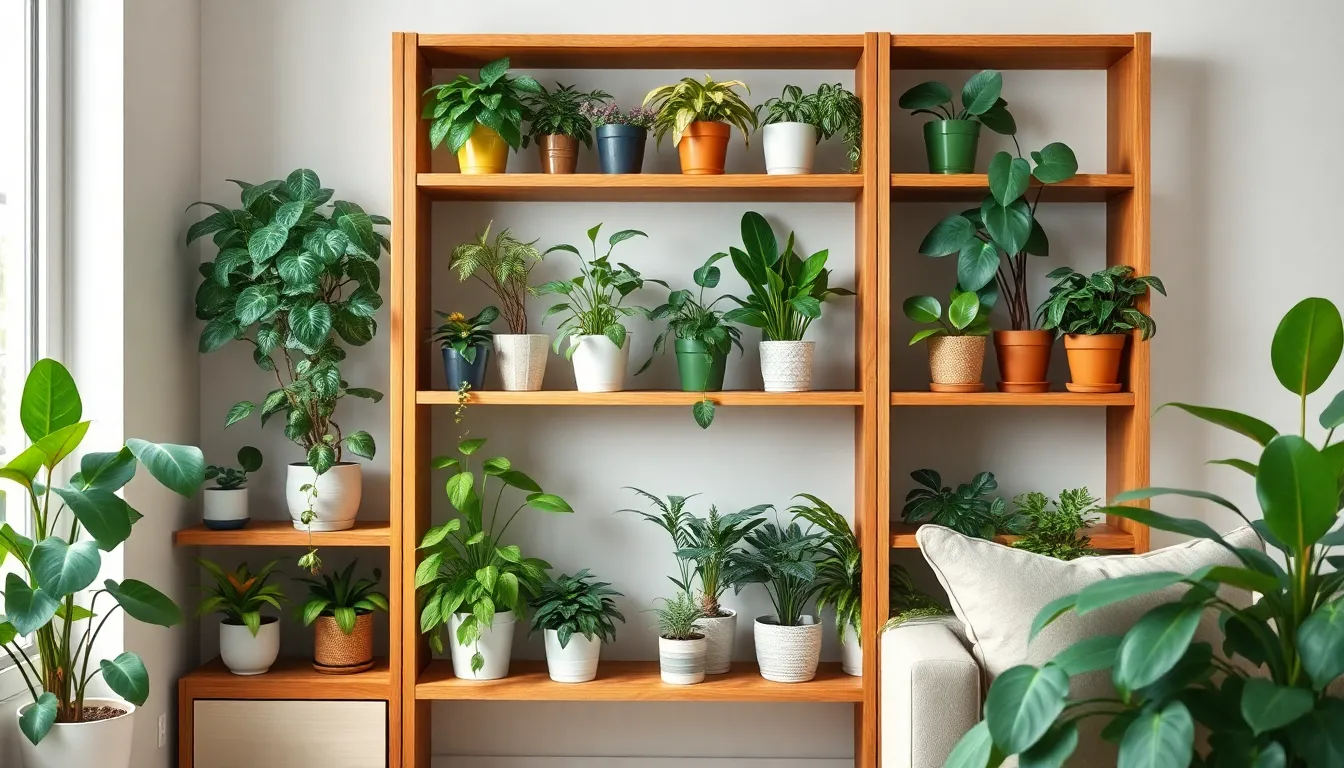
After selecting the ideal material for our corner shelves, we need to ensure they can safely support our plant collection. Weight capacity varies significantly across different shelf models, ranging from 30 lbs per shelf up to 150 lbs total capacity.
Calculate Total Weight Including Soil and Water
We must account for more than just the plant itself when calculating weight requirements. The total weight includes the pot, soil, and water content, which can significantly increase the overall load on our shelves.
A medium potted plant typically weighs 10-20 lbs or more when the soil is wet. Multiplying this by the number of plants per shelf helps us determine if we’ll exceed the weight limit. For example, a metal 4-tier corner shelf supports about 77 lbs total, with roughly 30 lbs per shelf, while a rustic 6-tier metal and wood shelf holds up to 30 lbs per individual shelf.
Staying within or below the shelf’s maximum load bearing capacity prevents structural failure and potential damage to both our plants and home. Water adds considerable weight to our calculations, especially after thorough watering sessions when soil becomes saturated.
Match Shelf Size to Your Plant Collection
We should align our shelf dimensions with both the quantity and size of plants in our collection. A 5-tier wooden corner shelf accommodates 14-17 regular sized pots with a total capacity of 150 lbs, making it ideal for extensive plant displays.
Smaller collections work well with compact options like a 2 or 4-shelf plant stand that offers flexibility for fewer plants or smaller containers. A 6-tier shelf provides excellent versatility for mixing small to medium plants throughout the vertical display.
Plant height and spread require careful consideration to prevent overcrowding or tipping hazards. Corner shelves maximize our available space while utilizing room corners effectively, making them perfect for small spaces or improving home décor with organized plant arrangements.
Select Corner Shelves Based on Your Space Dimensions
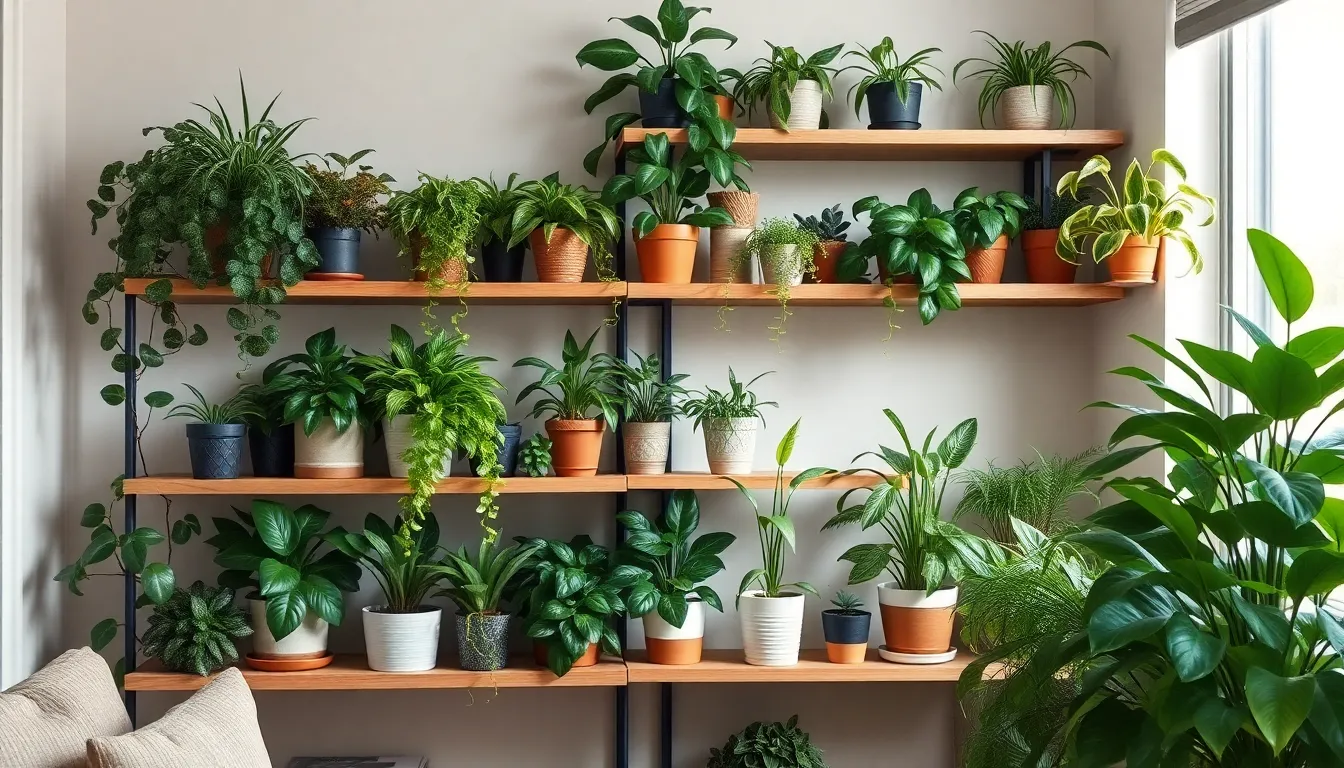
Choosing the right corner shelves starts with understanding your available space and how it’ll accommodate both current and future plant arrangements.
Measure Corner Height and Width Accurately
We need to measure the height and width of our corner space before making any shelf selections. Accurate measurements ensure that shelves fit snugly and maximize the use of corner areas without creating overcrowded displays.
Start by using a measuring tape to record the exact height from floor to ceiling in your chosen corner. Next, measure the width of both walls that form the corner space. Document these dimensions carefully since they’ll determine which shelf sizes and configurations work best for your exact area.
Consider any obstacles that might affect shelf placement, such as baseboards, electrical outlets, or existing furniture. These elements can impact where we position our shelves and how much usable space we actually have for our plant display.
Account for Plant Growth and Spreading
We must plan for our plants’ future growth when determining shelf spacing and arrangement. Leave approximately 12 to 15 inches or more of vertical space between shelves to accommodate the height of growing plants and the spread of trailing vines.
Consider the mature size of each plant species in your collection rather than their current dimensions. Small seedlings can grow into substantial plants that need significantly more room, while trailing plants like pothos or ivy require extra space for their cascading growth patterns.
Factor in seasonal growth spurts when many houseplants experience rapid expansion during spring and summer months. This planning prevents us from having to reorganize our entire corner display as plants outgrow their allocated spaces.
Think about how different growth habits affect shelf requirements, such as upright plants that need vertical clearance versus sprawling plants that require horizontal space. This approach helps us create displays that remain functional and attractive as our plants mature and flourish.
Optimize Lighting Conditions for Corner Plant Displays
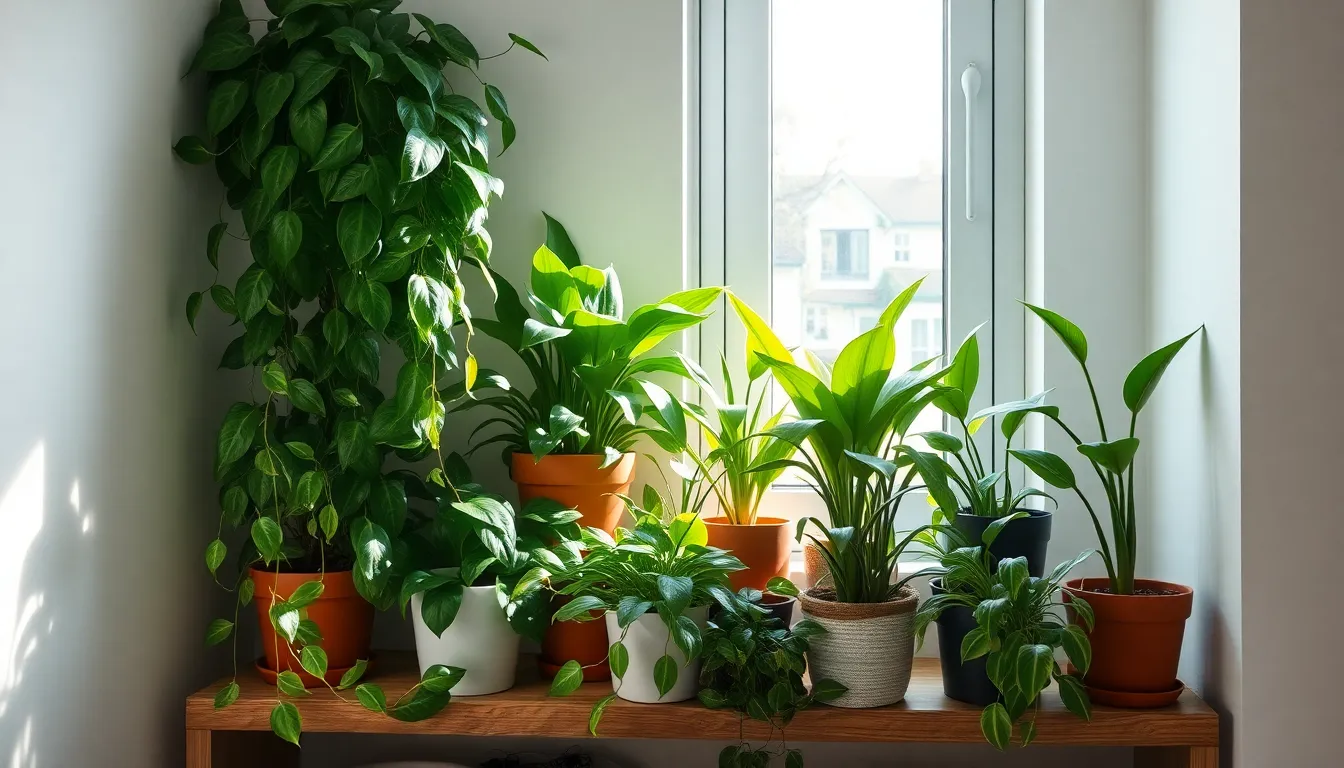
Now that we’ve established proper spacing and dimensions for our corner shelves, we need to address one of the most critical factors for plant success: lighting. Strategic light placement ensures our corner plant displays thrive regardless of their location in our homes.
Position Shelves Near Windows for Natural Light
Placing our corner plant shelves close to windows maximizes natural sunlight exposure, which provides the full spectrum plants need for photosynthesis and healthy growth. Natural light remains the primary and preferred lighting source for corner displays because it delivers optimal wavelengths without additional energy costs.
We should position shelves within 3-6 feet of windows to capture adequate light intensity throughout the day. East-facing windows offer gentle morning light that works well for most houseplants, while south-facing windows provide the strongest illumination for light-hungry species. North-facing windows deliver consistent but lower light levels, making them suitable for shade-tolerant plants like pothos and snake plants.
Rotating our shelves periodically ensures all plant sides receive equal light exposure, preventing uneven growth patterns. We can also use light-colored walls or mirrors near windows to reflect additional natural light onto our corner displays, amplifying the available illumination without extra equipment.
Add Grow Lights for Low-Light Corners
Installing grow lights becomes essential when our corners are positioned away from windows or receive limited natural sunlight. Multi-head grow lights ensure even illumination across all plants on our shelves, regardless of tier or placement, allowing versatile positioning throughout our indoor spaces.
LED grow lights offer the most efficient option, emitting less heat while providing full-spectrum lighting suitable for close placement to plants. We can position these lights above shelves or at corner angles to reach both upper and lower tiers effectively. Most LED grow lights consume 20-50 watts per fixture while delivering light equivalent to much higher wattage traditional bulbs.
Strategically placing grow lights at opposite ends of our shelves maximizes coverage without requiring complete setup rearrangement. We should secure wires neatly to maintain a tidy appearance and prevent tripping hazards around our corner displays.
Timer controls allow us to automate lighting schedules, typically providing 12-16 hours of supplemental light daily for most houseplants. Uplighting techniques can create soft ambient illumination and attractive shadows, improving our room’s overall design while supporting plant growth simultaneously.
Install Corner Shelves Safely and Securely
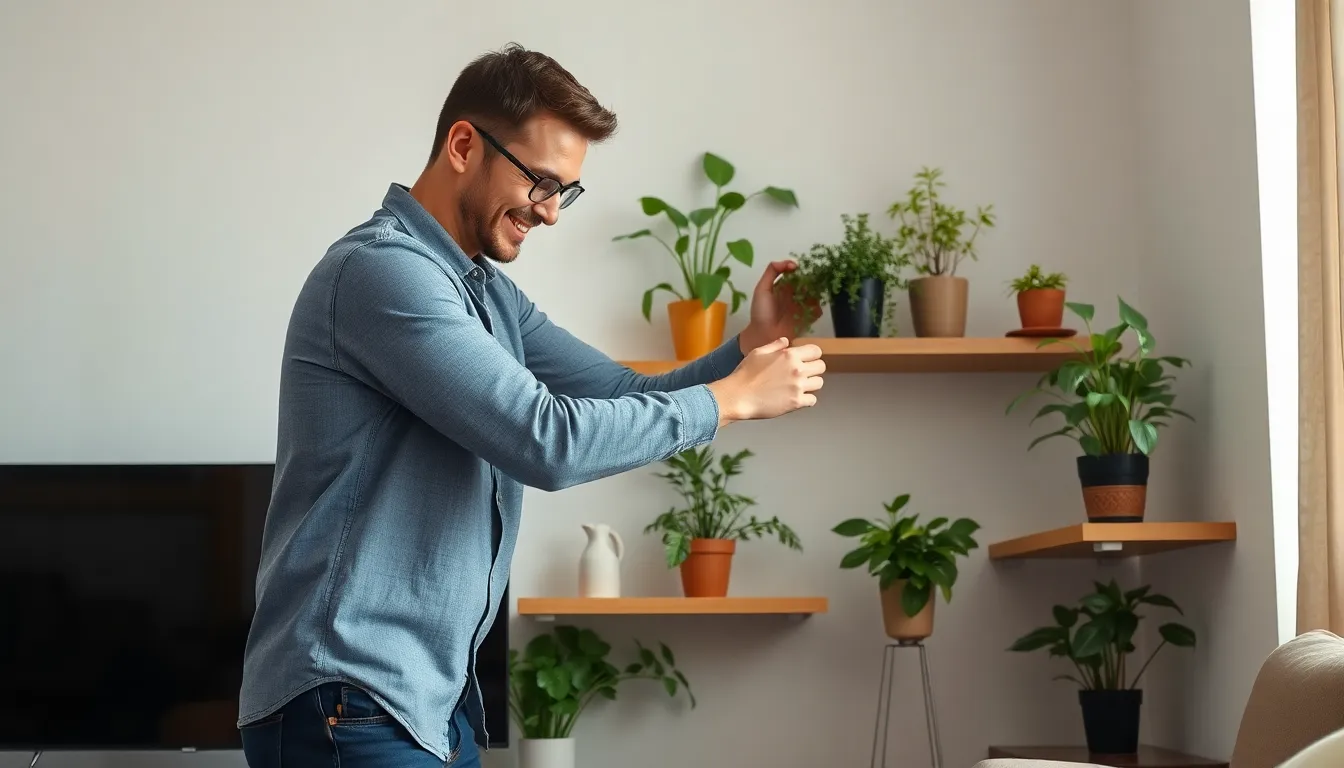
After measuring our space and choosing the perfect shelves, proper installation becomes critical for creating a safe and functional plant display. We must prioritize safety and stability to protect both our plants and our home.
Use Proper Wall Anchors and Mounting Hardware
Selecting appropriate wall anchors depends on our wall material and the shelf’s weight capacity. For drywall installations, we need wall anchors that can distribute weight effectively and prevent shelf pull-out. These anchors should match the total anticipated load of our shelves plus plants.
Pre-drilling holes ensures accurate placement and prevents wall damage. We should mark our bracket locations first, then drill holes at these marked spots. Wall anchors must sit flush with the wall surface for optimal support.
Wall studs provide the strongest mounting option for heavier plant displays. When we locate studs, we can pre-drill directly into the wood for maximum security. This method works best for shelves supporting multiple large plants or when our plant collection exceeds 30-40 lbs total weight.
Heavy-duty brackets become essential for substantial plant collections. We should choose mounting hardware that exceeds our calculated weight requirements by at least 25%. Screws must be tightened firmly without over-tightening, which can strip threads or crack brackets.
Ensure Level Installation for Plant Stability
Level installation prevents plant pots from tipping and causing water damage. We must use a level tool to confirm that each bracket sits perfectly horizontal before final tightening. Even slight angles can cause pots to slide or tip over time.
Adjusting bracket alignment before permanent attachment saves time and frustration. We should check level measurements multiple times during installation, making small adjustments as needed. This extra attention prevents costly mistakes and ensures our plants remain stable.
Securing shelves properly after bracket installation completes the safety process. We need to slide shelves onto brackets and fasten them according to manufacturer specifications. Regular inspection of our installed shelves helps identify any loosening hardware before problems develop.
Testing weight capacity gradually protects our investment. We should start with lighter plants and gradually add heavier specimens while monitoring for any sagging or movement. This approach helps us identify potential issues before they become safety hazards.
Arrange Plants Strategically on Corner Shelves
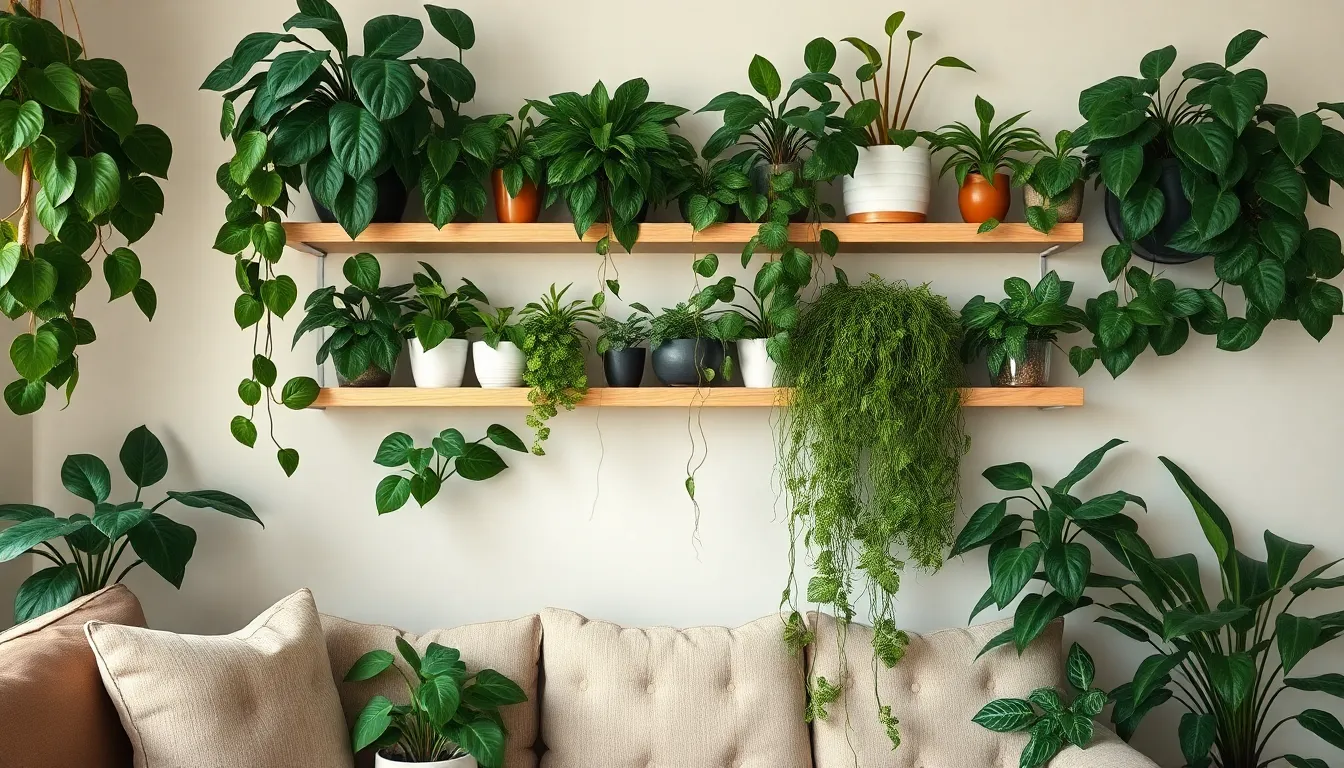
Strategic plant arrangement transforms our corner shelves into visually stunning displays while promoting optimal plant health. We’ll maximize both functionality and aesthetic appeal by implementing proven placement techniques.
Place Tall Plants on Bottom Shelves
Positioning taller plants on bottom shelves anchors our entire display and creates a stable foundation for the arrangement. Large leafy species like fiddle leaf figs, snake plants, and monstera deliciosa work best at ground level where they can support their own height and weight requirements without compromising shelf stability.
Bottom placement prevents tall plants from overshadowing smaller specimens above them, ensuring every plant receives adequate light exposure. We’ll create better light distribution across all levels when taller foliage doesn’t block natural sunlight from reaching upper shelves.
Heavy planters naturally belong on lower shelves where they won’t stress mounting hardware or create top-heavy configurations. Large potted plants can weigh 20-30 pounds when fully watered, making bottom placement both practical and safe for our corner shelf system.
Position Trailing Plants on Upper Levels
Trailing plants like pothos, string of pearls, and string of hearts shine on upper shelves where their cascading vines create elegant downward movement. We’ll achieve that coveted floating garden effect when trailing foliage gracefully drapes from elevated positions.
Upper shelf placement protects delicate trailing vines from foot traffic and accidental damage while maximizing their dramatic visual impact. These plants naturally grow downward in their native environments, making elevated positioning feel organic and appropriate.
Macramé hangers work beautifully with top shelf trailing plants to add extra dimension and layered texture to our corner display. We can combine different hanging heights with shelf-mounted trailing varieties to create ever-changing depth throughout the vertical space.
This arrangement reduces floor clutter while allowing trailing plants to express their natural growth patterns without interference from other plants or household activities.
Maintain Proper Drainage and Water Management
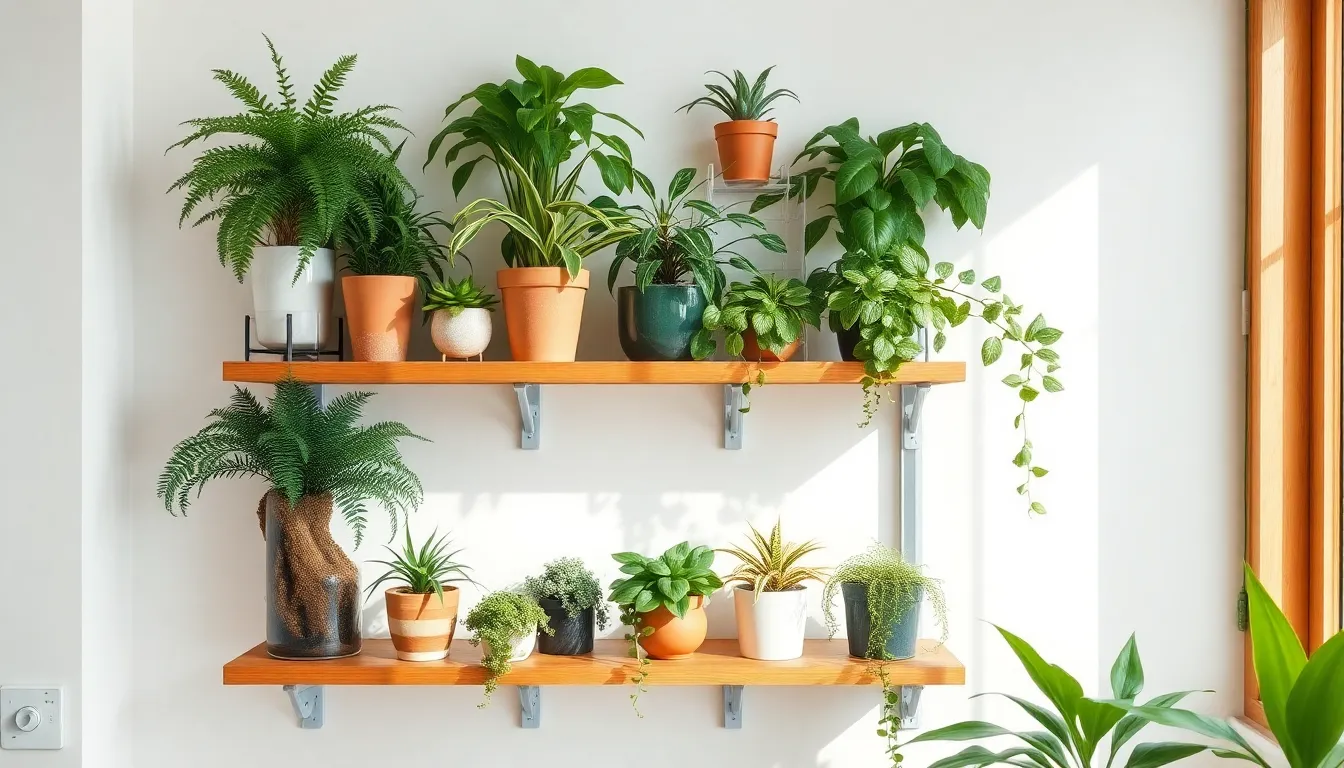
We’ve covered shelf installation and plant arrangement strategies, but now we need to address the foundation of healthy plant displays: proper water management. Effective drainage systems protect both our plants and our corner shelves from water damage while ensuring optimal growing conditions.
Use Drip Trays to Protect Surfaces
Drip trays serve as essential barriers between our plant pots and corner shelf surfaces, preventing water stains and structural damage. We recommend placing these protective trays under every plant pot to catch excess water that drains from the soil during watering.
Smart tray selection makes all the difference for corner shelf success. We should choose trays that are easy to remove and clean regularly to prevent mold buildup that can compromise both plant health and air quality. For corner shelves specifically, slim profile or custom fit drip trays maximize our available space while maintaining the aesthetic appeal of our plant displays.
Regular maintenance keeps our drainage system functioning effectively. We need to empty accumulated water from trays within 24 hours to prevent root rot and mosquito breeding. Clear plastic trays work well because we can easily monitor water levels without lifting heavy plants.
Consider Self-Watering Systems for Convenience
Self-watering systems revolutionize plant care on corner shelves by automating hydration and reducing the risk of overwatering or water spills. These systems prove especially valuable for multi level corner displays where frequent manual watering becomes inconvenient and time consuming.
Drip irrigation kits like the LetPot Automatic Watering System deliver precise water amounts directly to each plant’s base through adjustable drippers. We can manage watering schedules via smartphone apps and monitor real time water levels for up to 20 plants simultaneously. This technology ensures consistent hydration while preventing water overflow onto our shelf surfaces.
Self-watering planters such as Ecopots use wicking irrigation systems where water stored in bottom reservoirs gets drawn up into the soil as plants need it. These planters maintain optimal moisture levels automatically without creating excess water that could damage our corner shelves or surrounding walls.
DIY drip systems offer budget friendly alternatives using repurposed water bottles with small holes in the caps. We can create slow release watering by inverting these bottles into the soil, providing steady hydration that keeps plants healthy while minimizing water spillage risks on our corner shelf installations.
Style Your Corner Plant Shelves for Maximum Impact
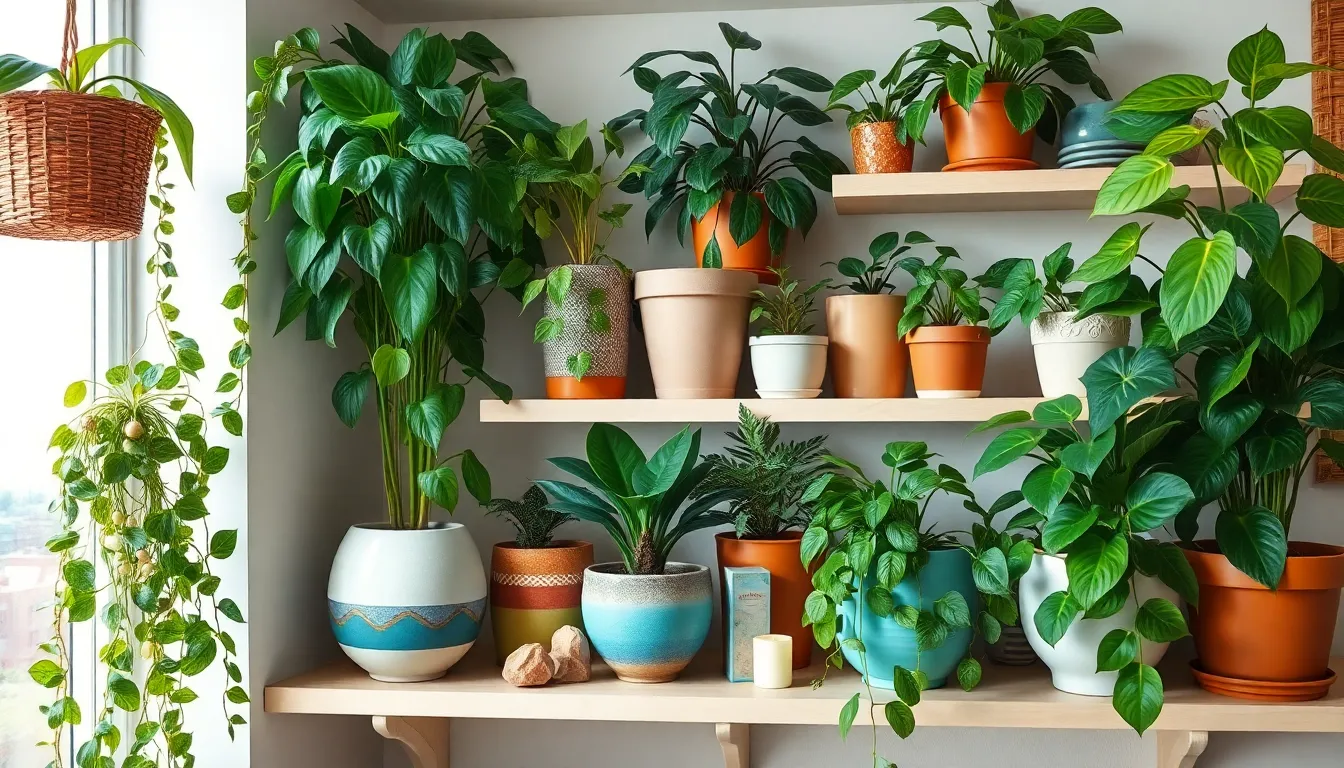
We’ll transform your corner shelves into stunning focal points through strategic styling and thoughtful arrangement decisions. Maximizing visual impact requires careful consideration of plant selection, decorative elements, and overall design harmony.
Mix Plant Varieties for Visual Interest
Combining different plant shapes and sizes creates texture and depth that draws the eye naturally. Trailing plants like string of pearls and string of hearts work beautifully alongside upright varieties such as philodendron or cacti. We recommend positioning trailing species at the top shelves where their cascading vines can flow downward, improving the visual flow of your entire display.
Arranging plants based on their light needs and growth habits ensures both aesthetic appeal and plant health. Plants requiring more light perform best on higher shelves, while shade tolerant varieties thrive on lower levels. This strategic placement allows us to create layered displays that look intentional while meeting each plant’s exact requirements.
Varying pot colors and shapes adds whimsy and breaks monotony throughout your corner display. Different container forms contribute to a lively plant corner that feels ever-changing rather than static. We suggest mixing ceramic, terracotta, and woven baskets to introduce textural variety alongside your diverse plant collection.
Incorporate Decorative Elements and Accessories
Adding non plant decor personalizes and enhances your shelf display beyond basic greenery. Gemstones, candles, and small curios placed strategically on shelves alongside plants create conversation pieces and reflect your personality. We find that these decorative touches help bridge the gap between functional plant care and artistic home styling.
Including functional accessories supports both plant growth and visual appeal in challenging spaces. Grow lights installed above shelves can support plant development in low light areas, while humidifiers placed nearby maintain suitable moisture levels. These practical additions ensure your corner plant shelves remain healthy and vibrant year round.
Balancing weight and stability prevents accidents while maintaining an attractive arrangement. For taller, multi tiered shelves, we recommend placing heavier pots on lower tiers and lighter ones above to ensure sturdiness and safety. This approach allows us to create impressive displays without compromising the structural integrity of our corner shelf installations.
Troubleshoot Common Corner Shelf Plant Problems
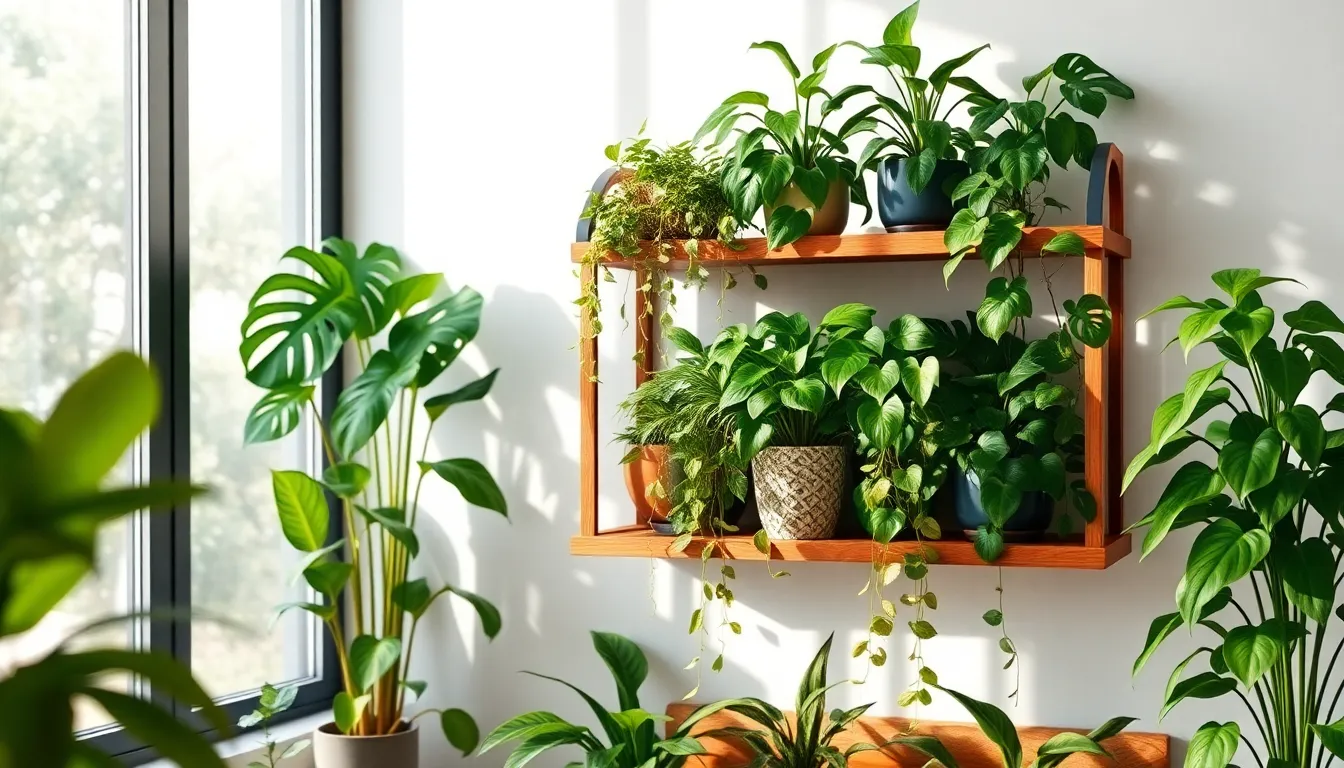
Even the most carefully planned corner shelf displays can develop issues that affect both plant health and visual appeal. Let’s tackle these common challenges with proven answers.
Address Overcrowding Issues
Space plants strategically to prevent overcrowding on your corner shelves. We recommend leaving at least 2-3 inches between pots to allow proper airflow circulation and prevent fungal issues. Arrange plants by size and growth habit, placing smaller specimens in front of larger ones to ensure each plant receives adequate light exposure.
Create vertical layers using tiered stands or staggered shelf heights to maximize your growing space. This approach gives trailing plants like Heart Leaf Philodendron and Golden Pothos room to cascade without overwhelming neighboring plants.
Monitor growth patterns regularly and relocate fast-growing plants before they outgrow their designated spaces. Many corner shelf arrangements fail because we underestimate how quickly certain plants expand their footprint.
Rotate your plant collection every few days to ensure all sides receive balanced sunlight exposure. This practice prevents uneven growth that can contribute to overcrowding on one side of your display.
Manage Pest Control in Tight Spaces
Inspect plants weekly for early signs of spider mites, aphids, and other common pests that thrive in the stagnant air conditions often found in corner arrangements. Look for webbing, yellowing leaves, or tiny moving insects on leaf surfaces.
Improve airflow circulation by spacing plants adequately and occasionally moving them off shelves for thorough cleaning and inspection. Poor air movement in tight corner spaces creates ideal breeding conditions for many plant pests.
Clean plant leaves regularly with water to remove dust buildup and early pest populations before they establish colonies. This simple maintenance step significantly reduces pest pressure in confined corner shelf environments.
Apply natural pest repellents like neem oil or insecticidal soap when you detect early infestations. These treatments work effectively in tight spaces without creating harmful chemical buildup that can affect multiple plants in close proximity.
Quarantine affected plants immediately by removing them from your corner display until treatment eliminates the pest problem. This prevents rapid spread to healthy neighboring plants in your confined shelf arrangement.
Conclusion
Corner shelves for plants offer an incredible opportunity to transform overlooked spaces into thriving green sanctuaries. We’ve covered everything from selecting the right materials and ensuring proper installation to optimizing lighting conditions and maintaining healthy plant displays.
By following our guidelines for weight capacity considerations strategic plant placement and effective drainage systems you’ll create stunning displays that enhance your home’s aesthetic appeal. Remember to start small and gradually build your collection while monitoring for common issues like overcrowding and pests.
With the right approach corner plant shelves become more than just storage answers—they’re living art pieces that bring nature indoors. Your unused corners can now flourish with greenery that purifies your air and elevates your living space.
Frequently Asked Questions
What are the best materials for corner plant shelves?
The three main materials are wood, metal, and plastic. Wood shelves like cedar and teak offer natural appeal and work well with trailing plants but require occasional maintenance. Metal shelves provide modern durability and can support heavier plants with minimal upkeep. Plastic shelves are budget-friendly, ideal for beginners and renters, with easy assembly and versatility for various decor styles.
How much weight can corner plant shelves typically hold?
Weight capacity varies significantly across different shelf models. You should account for the total weight including plants, pots, soil, and water. A medium potted plant can weigh 10-20 lbs or more when wet. Always check the manufacturer’s specifications and consider using heavy-duty brackets for substantial plant collections to ensure safety and stability.
How do I choose the right size corner shelf for my plants?
Measure your corner space accurately, considering height, width, and any obstacles like baseboards or electrical outlets. Match shelf size to your plant collection – larger shelves accommodate more pots while smaller shelves suit compact displays. Consider plant height and spread to avoid overcrowding and ensure proper light distribution for all plants.
What lighting considerations are important for corner plant shelves?
Position shelves near windows to maximize natural light exposure, which is crucial for plant health. Different window orientations suit different plant types. For corners with limited natural light, add LED grow lights with timer controls. Rotate shelves periodically to ensure even light distribution and consider the specific light requirements of your plant varieties.
How do I properly install corner shelves for plants?
Use appropriate wall anchors and mounting hardware based on your wall material and shelf weight capacity. Pre-drill holes, locate wall studs, and use heavy-duty brackets for stability. Ensure level installation to prevent tipping and water damage. Start with lighter plants to test weight capacity and conduct regular inspections to maintain shelf integrity.
How should I arrange plants on corner shelves?
Place taller plants on bottom shelves for stability and proper light distribution. Position heavy planters on lower shelves to avoid stressing mounting hardware. Put trailing plants on upper shelves where their cascading vines create elegant displays. Use macramé hangers to add dimension and ensure adequate spacing between plants for airflow.
What’s the best way to manage watering on corner shelves?
Use drip trays to protect shelf surfaces from water damage and select trays that fit well in corner spaces. Consider self-watering systems like drip irrigation kits or self-watering planters for consistent moisture levels. Regular maintenance of drip trays prevents root rot, and DIY slow-release watering methods can help minimize spillage risks.
How do I prevent common problems like overcrowding and pests?
Space plants strategically to allow proper airflow and light exposure. Create vertical layers to maximize space and regularly monitor growth patterns. Inspect plants regularly for pests, improve airflow, and use natural pest repellents when needed. Quarantine affected plants immediately to prevent the spread of infestations to healthy plants.

